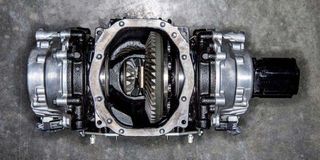Prime
Ask the Mechanic: What is the function of a differential?

Hello Paul, what is limited slip differential and how does it improve my drive?
Peter
Hello Peter, limited-slip differential (LSD) is a device that improves traction and stability when you are accelerating, particularly when driving in difficult conditions such as slippery or uneven terrain, corners and roundabouts. To understand what LSD does to improve your drive, it is useful to appreciate what a differential is and why a vehicle needs it.
A differential is a mechanical device designed to allow a flexible allocation of drive between wheels to enable cornering. This device facilitates the differences in wheel speed which naturally occur when a car turns a corner or drives in a circle through a roundabout.
The challenge during cornering is the inevitable buildup of tension when the outside wheel begins to rotate faster than the inside wheel due to the bigger arc it must drive through. This tension may try to find relief by a wheel slipping over the surface (loss of drive) or in a worst case scenario, snapping the shaft.
LSD will reduce the loss of drive, which occurs when wheels spin on one side of the axle. Wheel spin is likely to happen when driving through a corner with the foot firmly on the accelerator or accelerating a powerful car while driving away from stand still, especially on a slippery road surface. LSD reduces torque between the wheels by restricting unwanted wheel spin on one side of the axle. LSD also uses clutch packs to reallocate drive between the inner and outer wheels, which limits power to the high traction side and allows power to the low traction side. LSD enables the vehicle to overcome traction differences.
There are different types of LSD systems used to reduce undesirable wheel spin on one side of the axle and they use viscous, mechanical, hydraulic or electrical coupling systems. LSD application in older vehicles is rapidly being replaced by the more sophisticated and computer controlled Traction control systems (TCS), which employs sensors connected to the ABS (anti-lock braking system) to continuously monitor the speed of each wheel.
If the system detects a wheel or set of wheels spinning faster than the others, it automatically applies the brakes of that wheel or set of wheels. Some TCSs reduce engine performance by inhibiting the spark or restricting the throttle (air intake).
This withholds power to the spinning wheels to allow the other wheels restore balanced power and the driver to regain control of the vehicle. Usually, this happens passively without the driver manually intervening.
Send an email to: [email protected]




